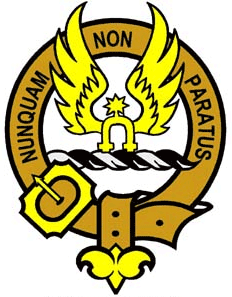Johnstone Clan
Johnstone Clan Crest: A winged spur rowel.
Johnstone Clan Motto: Nunquam Non Paratus (Never unprepared).
Johnstone Clan History:
A powerful Border clan which held the central lands of Annandale. The name Gilbert Johnstone appears after 1194. Wautier Jonesone of Berwickshire rendered homage to Edward I of England in 1296, and there is a tradition that it was the Johnstone Chief who warned Robert the Bruce that his life was in danger from Edward I, sending him a sign to flee from the English Court. His descendant was appointed Warden of the Western Marches in 1381.
The Johnstones thereafter became involved in the conflict between the Royal House of Stewart and the House of Douglas and were rewarded with confiscated lands near the Douglas stronghold of Threave Castle in Galloway.
A long standing feud existed with the Maxwells, who sometimes alternated with the Johnstones as Wardens of the West March. In the 16th century, the 8th Lord Maxwell was all powerful in the south-west of Scotland, but was killed at the battle of Dryfe Sands, near Lockerbie, in 1593. At a meeting to settle their differences fifteen years later, the Johnstone Chief was killed by the 9th Lord Maxwell. For this deed, Lord Maxwell was executed in 1614.
In 1633, James Johnstone was created Lord Johnstone of Lochwood by Charles I. In 1643, he was created Earl of Hartfell and fought for the Royalist Cause with the Marquis of Montrose. He was captured and imprisoned, but after the Restoration was given the additional earldom of Annandale.
In 1701, William, 3rd Earl of Hartfell and 2nd Earl of Annandale, Secretary of State for Scotland and President of the Privy Council, was created 1st Marquess of Annandale. He was succeeded by his two sons, but after the death of the 3rd Marquess the family titles became dormant and the Johnstone estates devolved upon the Hopetoun Family. In 1985, based on the Charter of 1662, the Johnstone Chiefship and the earldoms of Annandale and Hartfell were confirmed upon Patrick Johnstone of that Ilk.
Sir George Johnston of Caskieben, who claimed descent from Stiven de Johnston in the 14th century, was created a Baronet of Nova Scotia in 1626. The 3rd Baronet supported William of Orange at the Battle of the Boyne in Ireland in 1690.
Arthur Johnston (1587-1641), son of the Laird of Caskieben, became Rector of King's College, Aberdeen. Archibald Johnston of Warriston (1611-63) became a Lord of Session and Lord Advocate, and was a principal framer of the National Covenant. He took part in the Cromwellian administration and was executed in Edinburgh. Arthur Johnston (1587-1641), son of Archibald, served as Secretary of State for Scotland from 1692-06. Alexander Johnston (1804-71) co-founded with his brother William (1802-88) the map-producing firm of W. & A.K. Johnston in 1826. Thomas Johnston (1882-1965) was Secretary of State for Scotland from 1941-45.
Places of Interest:
The Devil's Beef Tub, near Moffat, Dumfriesshire. A dramatic hollow in the east Dumfriesshire landscape where Johnstone reivers (cattle thieves) hid the beasts they had stolen from across the Border.
Lockwood Tower, near Beattock, Dumfriesshire. This was a Johnstone stronghold burned by the Maxwells in 1593.
Caskieben, Blackburn, Aberdeenshire. This is a sixteenth century tower which was originally the Johnston stronghold in the North East. It was purchased from them by John Keith and is now called Keith Hall.
Surname distribution in Scotland: The Johnstone name is most commonly found in Highland (includes the historic counties of Caithness, Inverness-shire, Nairnshire, Ross and Cromarty, Sutherland and small areas of Argyllshire and Morayshire), Dumfries and Galloway (Dumfriesshire, Kirkcudbrightshire and Wigtownshire), Ayrshire, Falkirk, Stirlingshire, Clackmannanshire and the Scottish Borders (Berwickshire, Peeblesshire, Roxburghshire and Selkirkshire).
Associated family names (Septs): Johnston, Marchbanks, Marjoribanks, Rome.
Clan Johnstone membership prints.

